#electronics hardware
Text

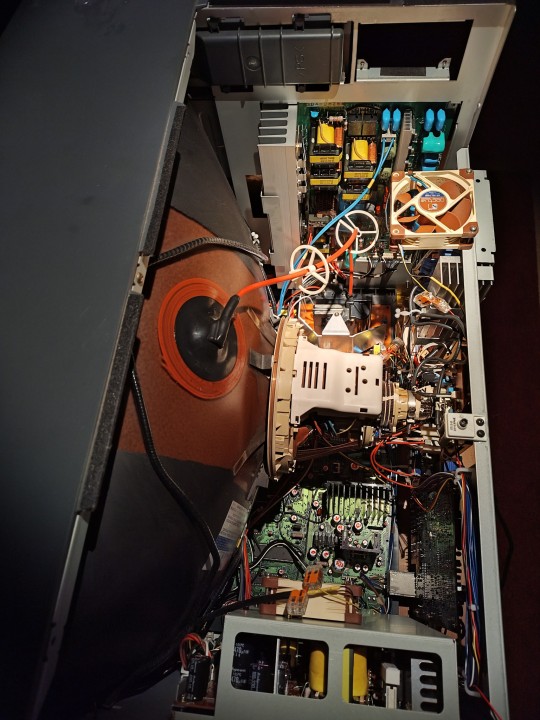

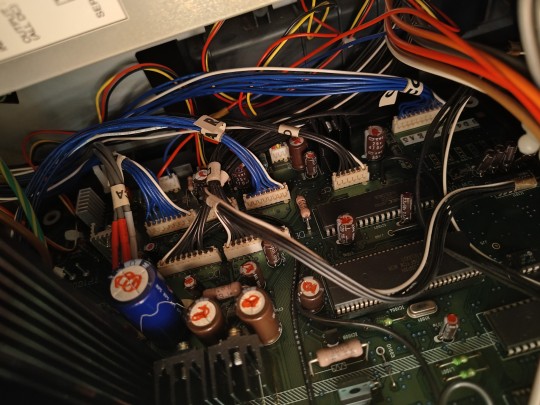
NEC XP29 Plus (Guts)
28" 95kHz
636 notes
·
View notes
Text
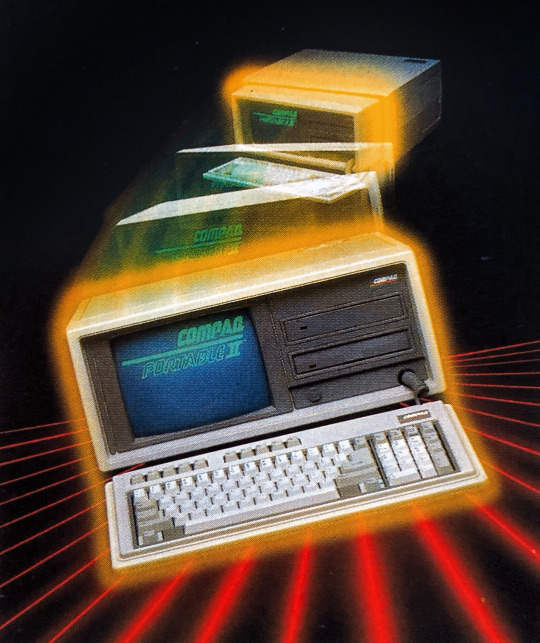
Compaq Portable II
#Compaq Portable II#Compaq#retro tech#retro ads#retro computing#retro graphics#retrowave#beige aesthetic#crt#80s tech#80s nostalgia#80s aesthetic#80s#retro#hardware#vintage design#vintage electronics#synthwave#vaporwave#glow aesthetic
216 notes
·
View notes
Text

Bare CPU Printed Circuit Board for the Alpha NT XL366 workstation I designed back in 1995 or so. This was an obscure model of an obscure product line, made by a company (Digital Equipment Corp.) that is now itself obscure. To be honest I don't even remember much about this machine now.
What I do remember is the HUUUUGE fight I got into with our Signal Integrity team while I was designing this, over decoupling capacitors.
Decoupling caps are small components that hold a charge to help even out power when a circuit is active. This board featured hundreds of them, smaller than a grain of rice (see photo comparison of mounting pads vs rice grain below).
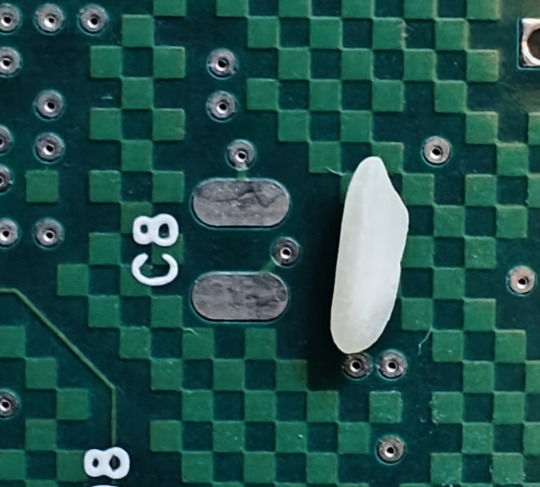
Our Signal Integrity team was tasked with making sure everything was electrically stable, so they required many hundreds of these to be added to the board, based on power simulations they did. Trouble was, they wanted so many, we couldn't even build the board.
My job as the Systems Engineer here was to meet the requirements from the SI team, but also from manufacturing, and the requirement that my PCB layout techs don't go insane trying to place and route the board. SI really only cared about signal quality, so they would not relent, and I ended up getting shouted at at one point by a junior SI engineer who was also under a lot of stress, when I said "There are different schools of thought on this.." and he screamed THERE ARE NOT DIFFERENT SCHOOLS OF THOUGHT ON THIS!!
It got to the point where the product was not going to get built, because we just couldn't fit like a thousand of these tiny caps on the board, we needed to ditch at least 25% of them to have a hope. The models were the models though, and you couldn't argue against them.
But then my boss got a genius idea. What if we could prove the simulation models were too conservative? We came up with an experiment where we would remove caps from an older system and measure the power supply noise, to see how many caps could be taken off before the system became unstable.
Me and the junior SI engineer were tasked with doing this experiment (later deemed The Decapitation Project), so we grabbed a Tektronix scope and Metcal soldering station and headed over to this abandoned lab we had in our old Maynard headquarters, a now creepy attic space on the 6th floor of an old mill building. Here were a few older Alphastation 3000 workstations we built years earlier, working but waiting to be recycled.
We had this special program that would thrash the CPU within an inch of its life, to put a big demand on the power supply system. While this was running, the SI engineer measured the power quality, while I proceeded to (very carefully to avoid short-circuiting the system) actually desolder caps from the board while the workstation was running.
We managed to get about 1/3 of them off before there was any noticeable effect, and we found one specific type of cap was not doing much of anything at all. We took the data back to the head of the SI team, and he finally relented and let us remove several hundred capacitors. (He also buried the report and data I had, because he didn't want the bad publicity - I remember being mad about that)
The system got built after that, and worked just fine. We did try to enact a small bit of petty revenge on the SI team manager though - there was a recognition event for people involved on the project, and me and our PCB procurement guy decided to give the SI team manager a special "Faraday Award" for achievement in capacitance (Farads are a measure of capacitance - geeky eng joke). We took an old bowling trophy with a giant, beer-can sized electrolytic capacitor strapped to the top of it as the award. He was a no-show so we didn't get to present it. Those SI guys never did have much of a sense of humor.
Anyway, long story sorry. Just thinking of it recently because I was helping someone at work with an analog simulation and I remembered this..
495 notes
·
View notes
Text

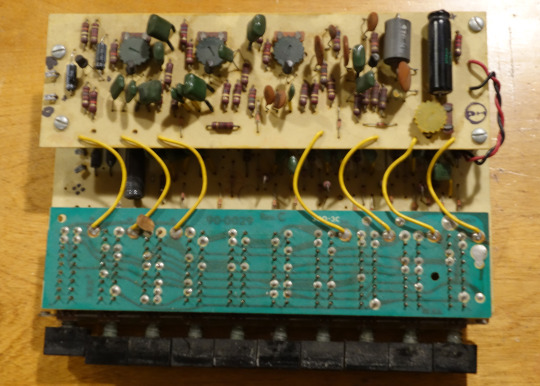

This is a Rhythm Master Drum Machine.
The machine has 4 voice circuits, they are on the board with visible components. From left to right; a kick drum, two toms/clavs, and a noise voice. The voices are triggered in different combinations to simulate 7 different drums, with varying degrees of verisimilitude.
There are 10 preset patterns selected by buttons on the front panel. Although not designed to play more then one pattern at a time, it is possible to force more then one button down at a time.
The machine has no memory, the patterns are etched onto the circuit board. All the other circuitry is made with discrete transistors.
This particular unit has no case, No idea how that happened. but I'm putting it into a 2u rack-mount enclosure. It also didn't work, but I fixed that some time ago.
#retro#vintage electronics#electronics#electronic music#electronics technician#diy electronics#retro tech#old tech#technology#hardware#teardown#infodump
164 notes
·
View notes
Text

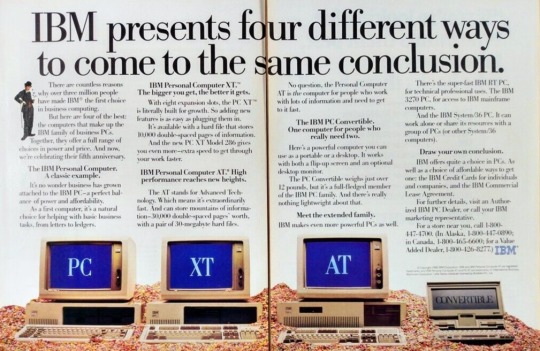


🇺🇸 Step back in time to 1986 and witness the dawn of a revolutionary device—the IBM PC Convertible. As one of the earliest portable computers, the PC Convertible marked a significant milestone in the evolution of American personal computing, offering newfound mobility and versatility to professionals and enthusiasts alike.
💻 The IBM PC Convertible represented IBM's inaugural foray into creating a portable version of its iconic PC line. It was the first laptop-style computer following the luggable IBM Portable, and notably introduced the 3½-inch floppy disk format to the IBM product line. Featuring a clamshell design this groundbreaking device set the stage for future generations of laptops. Its compact form factor and relatively lightweight made it a practical choice for on-the-go computing—a novel concept at the time.
⌨️ Unlike earlier portable computers that required external keyboards, the PC Convertible boasted a built-in keyboard, enhancing its usability and convenience.
👉 The PC Convertible came in three models: PC Convertible, PC Convertible Model 2, and Model 3. The latter two were released in October 1987 and are primarily distinguished by their LCD panels. The original Convertible used a non-backlit panel, which was considered difficult to read. The Model 2 lacked a backlight as well but upgraded to an improved supertwist panel, while the Model 3 included a backlight.
🖥️ Equipped with an innovative flip-up monochrome, CGA-compatible LCD screen, the PC Convertible offered a crisp display for viewing documents and running applications—a revolutionary feature for its time.
💾 Powered by an Intel 80C88 CPU, the PC Convertible came with built-in storage options, including 256 KB of RAM (expandable to 640 KB) and dual 720 KB 3.5-inch floppy drives, enabling users to store and access data with ease. It also featured serial and parallel ports for connecting peripherals.
🔋 Despite its modest battery life by today's standards, the PC Convertible offered respectable uptime, allowing users to work on the go without being tethered to a power source. Weighing just over 12 pounds and featuring a built-in carrying handle, the PC Convertible's battery was rated for 10 hours.
🌟 The IBM PC Convertible was succeeded in 1991 by the PS/2 L40 SX, and in Japan by the IBM Personal System/55note, the predecessor to the ThinkPad. The IBM PC Convertible left an indelible mark on the history of computing, paving the way for the modern laptops we use today. Its innovative design and practical features demonstrated the potential of portable computing, inspiring subsequent advancements in mobile technology.
#old technology#techtime chronicles#companies#tech#technology#old tech#technews#information technology#corporations#electronics#ibm#ibm corporation#ibm pc1#ibm pc#ibm pc convertible#laptops#laptop#computer science#computing#computers#computer#old computers#hardware#software#innovation#made in america#made in usa#floppy disk#thinkpad#ibm pc-line
49 notes
·
View notes
Text

électronique
#illustration#art#artists on tumblr#illustrators on tumblr#study#art study#lineart#hardware#electronics#drawing
187 notes
·
View notes
Text

USA 1997
#USA1997#MICRON ELECTRONICS INC.#HARDWARE#IBM#MICRON MILLENNIA MME#MICRON TRANSPORT#MICRON MILLENNIA XKU
73 notes
·
View notes
Text

PCB of the day! RA8875 Driver Board for 40-pin TFT Touch Displays - 800x480 Max 🖥️🔌🔬
#adafruit#pcb#pcboftheday#electronics#opensource#TFTdisplay#RA8875#driverboard#techinnovation#circuitdesign#touchscreen#electronicengineering#hardware#displaytechnology#gadgets
138 notes
·
View notes
Photo









Some aqua mice pics
#qq knockoffs#water mice#aqua#aquacore#aesthetic#2000s#nostalgia#nostalgiacore#tech#techcore#electronics#peripherals#computer mice#hardware#sanrio bootlegs#kidcore
479 notes
·
View notes
Text




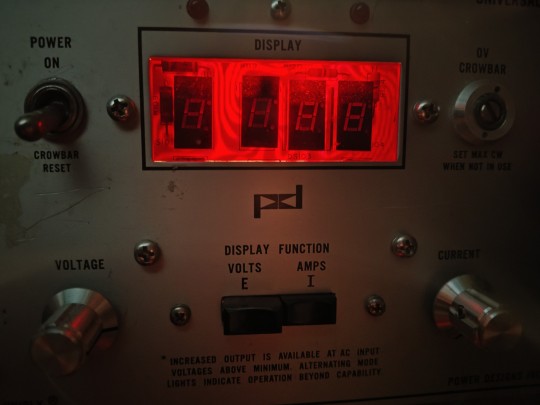
Power Designs Inc 6050C
60W Linear Power Supply R.I.P.
104 notes
·
View notes
Text
99 notes
·
View notes
Text


just another wild hardware hacking prototype for fun. now i know why nobody uses white PCBs, the solder burns are super obvious and painful to look at.
29 notes
·
View notes
Text

Using a multimeter from 1958 to fix a TV game from 2006 that emulates a console from 1977. This project is all over the place.
A $3 thrift store purchase I was pretty sure was broken, but luckily it did not power on at all. That's my favorite failure mode to fix, because it's usually something simple like broken battery wire or coroded terminal, or in this case, cruddy power switch.
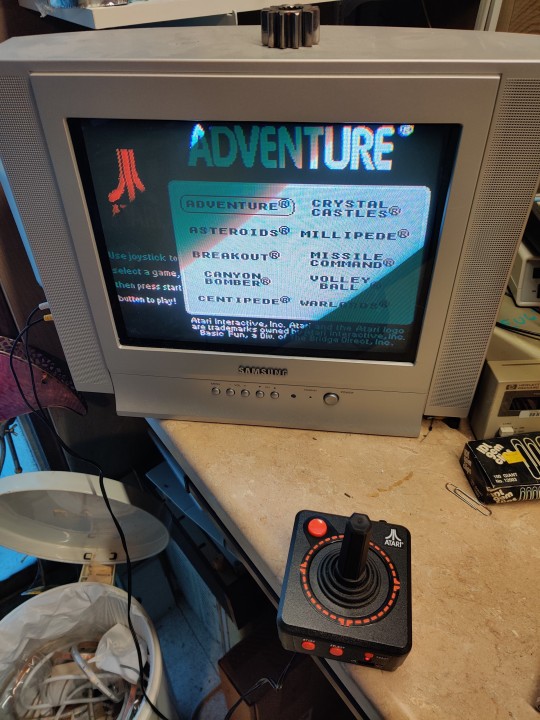
A little contact cleaner and it's back in business! Adventure, anyone? (Interesting aliasing effect here between the CRT refresh and my phone camera but not visible to the human eye)
111 notes
·
View notes
Text


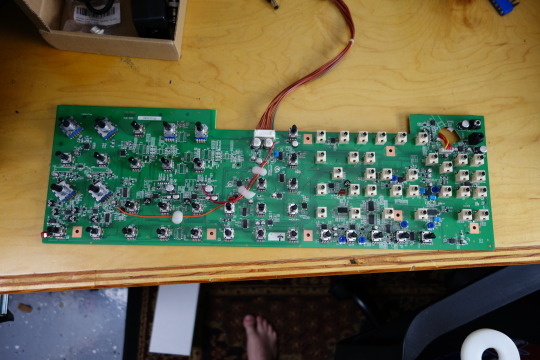
tear down photos from a recent repair of an ms20 mini.
#ms20#electronics#electronic music#analog synth#synthesizer#teardown#hardware#ms20 mini#ms20mini#electronics technician#synth
84 notes
·
View notes
Text
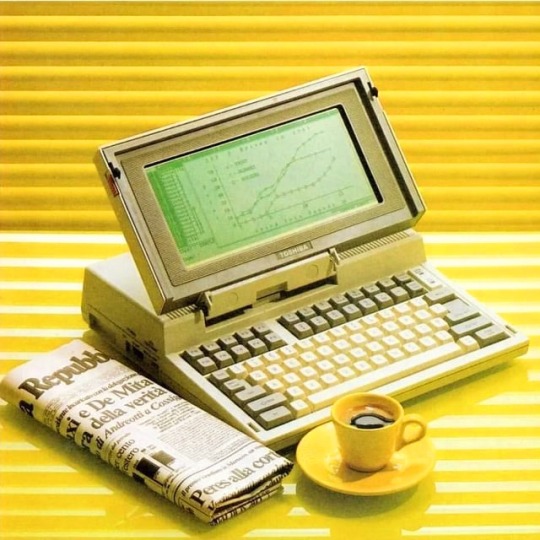




🇯🇵 Unveiling the Toshiba T1100: A Journey into the Dawn of Portable Computing!
💻 In the early 1980s, a revolutionary device emerged, transforming the landscape of personal computing forever. The Toshiba T1100, released in 1985, marked a significant milestone in the history of portable computers. The Toshiba T1100 has subsequently been described by Toshiba as "the world's first mass-market laptop computer".
🌐 The Toshiba T1100 was among the first truly portable computers, designed for professionals and enthusiasts seeking computing power on the go. Weighing approximately 4.1 kilograms (9 pounds) with its lead-acid battery, this innovative machine provided users with unprecedented mobility.
⚙️ Equipped with an Intel 80C88 processor running at 4.77 MHz and boasting 256 KB of RAM, the Toshiba T1100 offered impressive computing capabilities for its time. Its 9.6-inch monochrome LCD screen provided a crisp display, while the detachable keyboard enhanced usability.
💾 The T1100 introduced several innovative features, including a built-in 3.5-inch floppy disk drive—a rarity at the time—which allowed for data storage and transfer with ease. This model also featured MS-DOS as its operating system, providing a familiar computing environment.
📈 The Toshiba T1100 set a new standard for portable computing, demonstrating the feasibility and practicality of laptops for business and personal use. Its success paved the way for subsequent generations of laptops, influencing the evolution of mobile computing worldwide.
👨💻 For professionals in various industries, the Toshiba T1100 represented a game-changer, enabling efficient data management, word processing, and spreadsheet tasks on the move. Its portability and functionality empowered users to work beyond traditional office environments.
🌟 Today, the legacy of the Toshiba T1100 lives on in the sleek, lightweight laptops and notebooks that have become indispensable tools for modern professionals and digital nomads. This groundbreaking device remains a testament to Toshiba's commitment to innovation and excellence in the field of computing. The Toshiba T1100 remains an iconic symbol of the dawn of portable computing—a chapter in the ongoing story of technological progress that continues to shape our digital world.
#old technology#techtime chronicles#companies#tech#technology#old tech#technews#information technology#corporations#electronics#toshiba#t1100#toshiba t1100#laptop#laptops#portable computer#computer science#computing#computers#computer#hardware#software#1980s computers#1980s#innovation#made in japan#japan#retro tech#tech review#pc
14 notes
·
View notes
Text
if my sexuality weren't all so focused on fleshiness and heft and feeling very raw and organic i would almost certainly be one of those objectum girlies. i'm not a computerfucker but i believe in their beliefs
#really i just love picking apart the details of visual design especially with regards to electronics and hardware#elise.rtf
36 notes
·
View notes